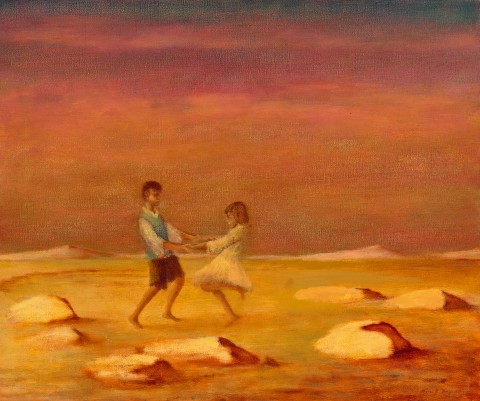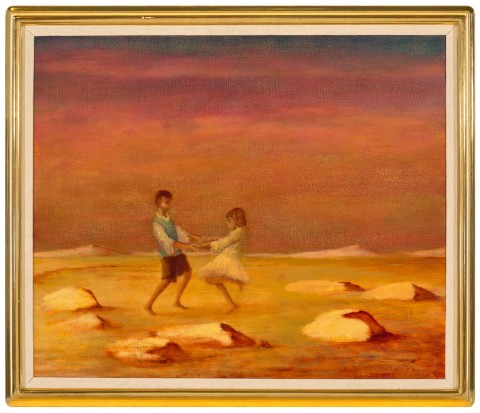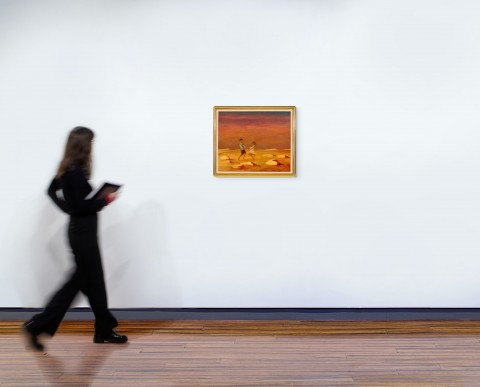THE DANCING CHILDREN, c.1971
RUSSELL DRYSDALE
oil on canvas
50.5 x 61.0 cm
signed lower right: Russell Drysdale
inscribed with title verso: "THE DANCING CHILDREN" / RUSSELL DRYSDALE / c/o THE LEICESTER GALLERIES, / 22A. CORK STREET. / LONDON. W. I.
Leicester Galleries, London
Joseph Brown Gallery, Melbourne
Private collection, Melbourne
Thence by descent
Private collection, Melbourne
Paintings, Drawings and Watercolours by Sir Russell Drysdale, Leicester Galleries, London, 16 June – 15 July 1972, cat. 27
Children Dancing, 1950, oil on canvas, 66.0 x 102.0 cm, private collection, sold Deutscher and Hackett, Melbourne, 3 May 2023, lot 12
Drysdale (1).jpg
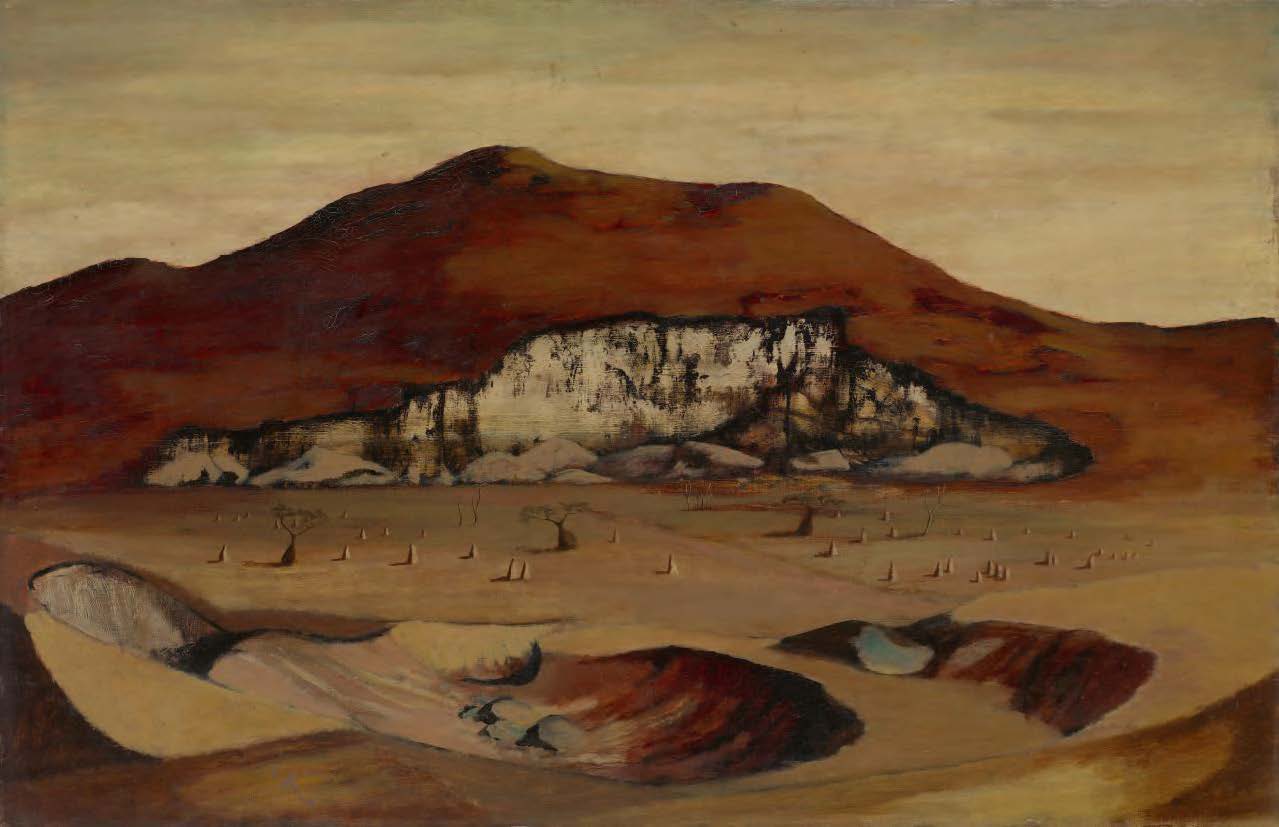
Within the ranks of the great Australian painters of the twentieth century, Russell Drysdale is distinguished by his ability to depict the Australian landscape and specifically, the psychologically charged relationship between the landscape and those who inhabit it. His colours are sun-bleached and pale, or the rich browns and reds of the earth, and the terrain he depicts is typically vast, flat and dry. Often described in the same tones and with a similar handling of paint, Drysdale’s figures rarely seem out of place, but the harshness of their environment and the profound sense of emptiness that pervades these landscapes communicates much about the strength, resilience and spirit of his subjects. As Drysdale explained, ‘[These] are the people that are fascinating. They’ve got this character. They are characters. You can take your society people, however beautiful they might be, but to me they’re ephemeral people. These others aren’t. They just go on. They’re the kind of towers that reach out. The survival thing that means something.’1
Drysdale’s first solo exhibition was held at Riddell Galleries, Melbourne in 1938 and received an overwhelmingly positive response, with Basil Burdett, the art critic for the Melbourne Herald, writing ‘I have seldom seen a more promising exhibition by a young painter anywhere.’2 During the next decade Drysdale held several more solo exhibitions and further recognition of his art followed with the awarding of the 1947 Wynne Prize and the 1949 Melrose Prize. His work also began to be collected by important institutions during these years. Monday Morning, 1938 was acquired by the Metropolitan Museum of Modern Art, New York in 1941 and the following year, both the National Gallery of Victoria and the Art Gallery of New South Wales purchased their first paintings by the artist, Moody’s Pub, 1941 and Sunday Evening, 1941, respectively.
Drysdale was one of a small handful of twentieth century Australian artists who achieved international recognition during his lifetime. His art was introduced to English audiences in a solo exhibition of recent paintings at Leicester Galleries in London in 1950. Including Emus in a landscape, 1950 (National Gallery of Australia) and Broken Mountain, 1950 (National Gallery of Victoria), the paintings shown in London drew on various sources, reflecting his experience of drought in New South Wales some years earlier, visits to Hill End (a once thriving gold mining town now full of ‘jovial mad peasants who live by fossicking and rabbiting’3) and more recent excursions through rural Queensland. Although London audiences were unfamiliar with the physical reality of Drysdale’s subject and sometimes challenged by the ruggedness of the landscape he described (so different to the picturesque English countryside which their artists depicted), his paintings struck a chord. Good sales – including one to Sir Laurence Olivier and another to the Tate Gallery – and positive reviews ensued.
Drysdale (2).jpg
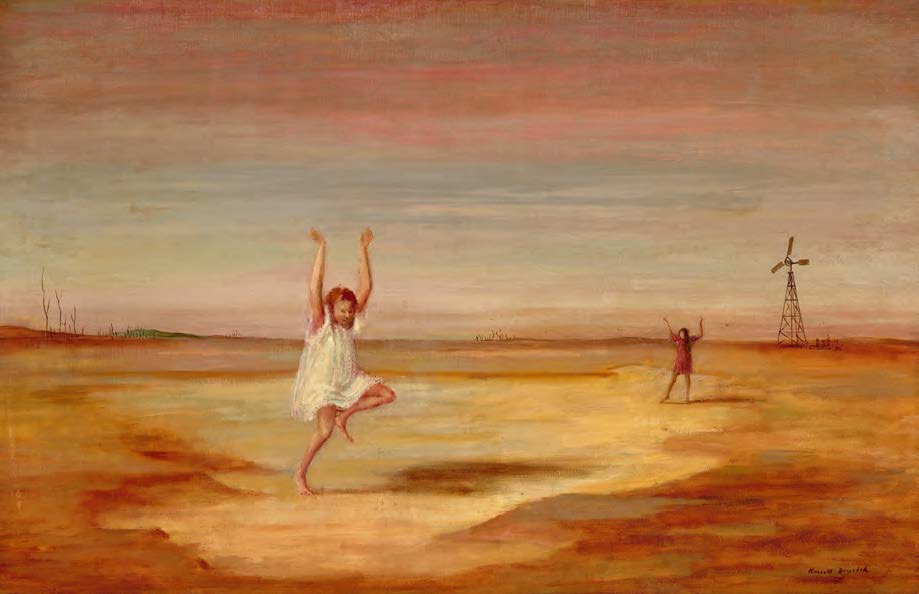
Further solo exhibitions at Leicester Galleries followed in 1958, 1965 and 1972 and The Dancing Children, c.1971 was included in the last of these, hanging alongside drawings, watercolours and important paintings such as The Mourner, 1968, and Grandma’s Sunday Walk, 1972 (both private collection). Depicting a young boy and girl holding hands and dancing barefoot in a flat, rocky landscape, this painting reprised a theme that Drysdale had explored more than twenty years earlier. The 1949 canvas, Children Dancing (private collection), shows two girls in a similarly harsh environment, although in this version, Drysdale has elaborated on the setting, opening it up with low-lying hills just visible on the horizon and incorporating additional details such as tall, spindly trees and a distant windmill. While for a local audience at least, these details clearly locate the scene in the Australian outback, they also demonstrate how the artist developed his paintings, carefully orchestrating the atmosphere and the feelings they evoke. The 1949 painting was evocatively described as ‘a rare, beautiful, and tragic canvas, in which two children dance against an empty landscape, not to music, but to the silence of their red and rainless outback world’4, and this applies just as easily to the current work. What comes through most powerfully in Drysdale’s exploration of this theme, however, is the carefree delight and energy of the dancing children. Something observed by Drysdale perhaps and remembered, and a universal expression of the joy and freedom of childhood.
1. Drysdale interviewed by Geoffrey Dutton, cited in Dutton, G., Russell Drysdale, Thames & Hudson, London, 1964, p. 100
2. Burdett, B., ‘Young painter shows brilliant promise’, Herald, Melbourne, 26 April 1938, p. 10 cited in Smith, G., Russell Drysdale 1912-81, National Gallery of Victoria, Melbourne, 1997, p. 19
3. Donald Friend, diary entry, 22 August 1947, quoted in Klepac, L., Russell Drysdale, Murdoch Books, Millers Point, 2009, p. 161
4. McKie, R., ‘Drysdale takes Australia to London’, The Daily Telegraph, Sydney, 12 October 1950, p. 8
KIRSTY GRANT
